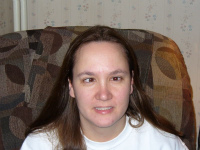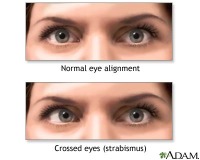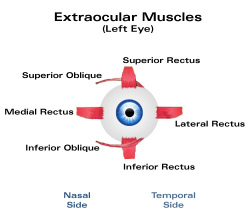|
What is Meant by Crossed Eyes?
Does one of your eyes turn in? Does one of your child’s eyes turn in? Does the eye turn become more apparent when you are tired? Or in the case of your child when he or she is tired? You may have Crossed Eyes. 
Crossed Eyes means both eyes can move, but one is out of alignment with the other, like the front wheels of a car. It could be that glasses or eye muscle surgery or both will be necessary to straighten your eyes. Children rarely outgrow this condition.
What are the Causes?
Muscles surrounding the outside of the eyeball (otherwise known as extra-ocular muscles) are responsible for eye movements. In the case of Crossed Eyes, the muscles are not working in synchrony with each other. A particular muscle may be exerting stronger force than the others and so forcing the eye to move in the direction of its force of action or a muscle may be weaker than the others, allowing the other muscles to dominate the eye movement.
When the focusing muscles are used, they cause an associated convergence movement of the extraocular muscles to bring the eyes in toward the nose for near viewing. The problem arises if you (or your child) need to focus at distance and even more so at near viewing, and the associated convergence causes Crossed Eyes. Glasses often can help move the eyes outward by relaxing the need to focus, and thus converge, to see clearly. Some children do outgrow Hyperopia and so the need to wear glasses may decrease with age, but not always. Now if your Crossed Eyes occur acutely, there are other serious potential causes: How are They Diagnosed?
Routine eye exams are the best way to diagnose this condition. If you notice your young child has an eye turn consulting an eye care provider is your best alternative. Early detection is critical in order to reduce the risk of 
Amblyopia. Amblyopia is a condition where there is decreased vision in an eye even with the best correction in place. Common reasons for this include a large difference in eyeglass prescription between the eyes or an eye turn. If your child has an eye turn that is constant in one eye and only occurs in that eye, then his or her risk of Amblyopia is greater. The eye doctor will measure your child’s refractive state to check for Hyperopia. Also, the degree of eye turn will be measured. Your child may complain of double vision, and may even close one eye when doing near work. Thus, his or her visual discomfort will also be taken into account in making the diagnosis. These findings will help the eye doctor decide the best course of action to manage your Crossed Eyes. How is This Treated and Managed?
Depending on the cause, your eye care provider will make a decision for treatment based on several factors such as: If the eye turn is significant and especially if discovered early in life, then surgery can be done to the extra-ocular muscles in order to align the eye better. The treatment may include any or all of the following options: If the Crossed Eyes occurred acutely, notify your eye doctor immediately as this could be a sign of a serious condition. Treatment of course would be geared to managing the underlying condition causing the Crossed Eyes, and using either a patch or prism to help you deal with the double vision. |





 Crossed Eyes is often associated with
Crossed Eyes is often associated with